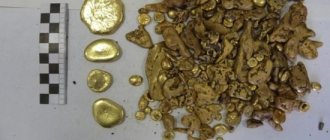1. Conducting a transaction related to precious metals, natural precious stones or pearls, in violation of the rules established by the legislation of the Russian Federation, as well as illegal storage, transportation or shipment of precious metals, natural precious stones or pearls in any form, condition, with the exception of jewelry and household products and scrap of such products, committed on a large scale - is punishable by forced labor for a term of up to five years or imprisonment for the same term with a fine in the amount of up to five hundred thousand rubles or in the amount of the wages or other income of the convicted person for a period of up to three years or without it.
2. The same acts committed by an organized group or a group of persons by prior conspiracy are punishable by forced labor for a term of up to five years or imprisonment for a term of up to seven years with a fine in the amount of up to one million rubles or in the amount of the wages or other income of the convicted person. for a period of up to five years or without it.
Part 1 art. 191 of the Criminal Code of the Russian Federation
Conducting a transaction related to precious metals, natural precious stones or pearls, in violation of the rules established by the legislation of the Russian Federation, as well as illegal storage, transportation or shipment of precious metals, natural precious stones or pearls in any form, condition, with the exception of jewelry and household products and scrap of such products, committed on a large scale - is punishable by forced labor for a term of up to five years or imprisonment for the same term with a fine in the amount of up to five hundred thousand rubles or in the amount of the wages or other income of the convicted person for a period of up to three years. or without it.
Part 2 art. 191 of the Criminal Code of the Russian Federation
The same acts committed by an organized group or a group of persons by prior conspiracy are punishable by forced labor for a term of up to five years or imprisonment for a term of up to seven years with a fine in the amount of up to one million rubles or in the amount of the wages or other income of the convicted person for the period up to five years or without it.
Article 190 of the Criminal Code of the Russian Federation. Non-return of cultural property to the territory of the Russian Federation
Article 191.1 of the Criminal Code of the Russian Federation. Acquisition, storage, transportation, processing for marketing purposes or sale of knowingly illegally harvested wood
Table of contents
Commentary to Art. 191 of the Criminal Code of the Russian Federation
Commentary edited by Esakova G.A.
1. Subject of the crime: a) precious metals - gold, silver, platinum and platinum group metals (palladium, iridium, rhodium, ruthenium and osmium). Precious metals can be in any condition, form, including native and refined form, as well as in raw materials, alloys, semi-finished products, industrial products, chemical compounds, coins, scrap and industrial and consumer waste; b) precious stones - natural diamonds, emeralds, rubies, sapphires and alexandrites; c) natural pearls in raw (natural) and processed form; d) unique amber formations.
The subject of the crime does not include jewelry and household products and scrap of such products. The absence of an assay mark on a product made of precious metals or a certificate for a cut stone does not turn it into the subject of a crime. However, uncut stones that have undergone preliminary mechanical processing cannot be classified as jewelry.
2. Criminal liability under Art. 191 of the Criminal Code is punishable for any transactions with precious stones and precious metals made in violation of the law. The illegality of such transactions may be due to the illegality of their extraction and production, and the lack of a license to carry out such actions. Transactions involving the subject of a crime concluded between individuals are considered illegal. Purchasing organizations and individual enterprises are prohibited from buying rough diamonds, unprocessed natural pearls and precious stones, etc. Mined and produced precious metals, with the exception of nuggets, after the necessary processing, must be sent for refining to organizations included in the list approved by the Government of the Russian Federation. The procedure for carrying out transactions with mineral raw materials containing precious metals before refining is determined by the Government of the Russian Federation.
3. Illegal storage, transportation, forwarding will occur in the case when these items were illegally obtained or produced, stolen, obtained as a result of committing any other crime, or acquired as a result of an illegal transaction.
4. Illegal trafficking in precious metals, natural precious stones or pearls entails criminal liability only if carried out on a large scale (over 2.25 million rubles).
5. The theft of precious metals or precious stones with the subsequent conclusion of illegal transactions with them requires qualification for a set of crimes.
6. Illegal (in the absence of a license) mining and production of precious metals and stones with their subsequent storage, shipment and transportation are qualified under the totality of Art. 171 and 191 of the Criminal Code (except for the situation when these actions are performed by an individual entrepreneur, since a license for the extraction and production of precious metals and stones is issued only to organizations).
7. Illegal production by citizens of jewelry, dentures and other household products from precious metals and precious stones belonging to the manufacturer or customer, as well as the production of these items from jewelry and other household products consisting of precious metals and precious stones, as well as scrap of such products, is not may be considered illegal trafficking in precious metals and stones. Such actions, if there are appropriate signs, must be qualified under Art. 171 CC.
How is the investigation into illegal trafficking of precious metals going?
The investigation begins with the fact of contacting law enforcement agencies. This is done by a witness or victim of the actions of attackers. If no one’s interests have been infringed or no one knows about the transaction or storage, then there are no grounds for initiating a criminal case, and the investigation will not begin.
The second thing that is necessary for the investigation is the subject of the crime, i.e. precious stones or metals. If a deal was made, then they must be somewhere, and discovering their whereabouts is a key point in the investigation. When the subject of a crime is discovered, it is removed from the storage location in compliance with the appropriate procedures. Then the materials are sent for examination, and only after receiving its results can the investigative authorities demand documents about the transaction.
The last stage is determining the authenticity and legality of the documents themselves. If they do not comply with the rules established by law, then the transaction is considered illegal, and its participants are considered criminals.
At any of these stages, the case may be closed due to the inability to move to the next stage of the investigation:
- At the application stage - if no one contacted the investigative authorities or the applicant refused the application;
- At the stage of searching for jewelry - if they were not found or were seized without paperwork;
- At the examination stage - if the materials were recognized as not subject to special accounting, namely: They are not jewelry;
- Not suitable for jewelry processing;
- Artificially grown;
In any case, the wording would be to close the case for lack of corpus delicti.
Commentary on Article 191 of the Criminal Code of the Russian Federation
Commentary edited by Rarog A.I.
1. The direct object of the crime is social relations developing in the sphere of state regulation of the turnover of precious metals, natural precious stones and pearls. The subject of the crime are precious metals, natural gemstones and pearls. In accordance with Art. 1 of the Federal Law of March 26, 1998 N 41-FZ “On Precious Metals and Precious Stones”, precious metals include gold, silver, platinum and platinum group metals (palladium, iridium, rhodium, ruthenium and osmium) in any condition and form . Natural precious stones include natural diamonds, emeralds, rubies, sapphires and alexandrites in raw (natural) and processed form, as well as unique amber formations equated to precious stones in the manner established by the Government of the Russian Federation (Resolution of the Government of the Russian Federation of January 5, 1999 No. N 8 “On approval of the Procedure for classifying unique amber formations as precious stones”). Pearls as the subject of a crime in the composition under consideration include natural pearls in raw (natural) and processed forms: Oriental sea pearls measured in carats, other varieties of sea pearls, as well as freshwater (river) pearls.
Artificial pearls and drilled (string) pearls, as well as jewelry and household products made of precious metals, natural precious stones and pearls and scrap of such products are excluded from the crime items. Jewelry includes decorations of various types and purposes; household items - items intended for table setting and room decoration; used for religious, decorative and dental purposes or for performing various rites or rituals; monetary and anniversary signs, medals, etc. (Regulations on the procedure for classifying products containing precious metals as jewelry, approved by Order of the Russian Federation Committee on Precious Metals and Precious Stones dated October 30, 1996 N 146). Scrap of jewelry and household items includes all products of this kind that are unsuitable for any reason for their intended use.
2. The objective side is characterized by alternatively specified actions, united under the general concept of illegal trafficking in precious metals, natural precious stones or pearls.
As the first alternatively specified action, the law calls the completion of a transaction related to precious metals, natural precious stones or pearls, in violation of the rules established by law. This involves a violation of the norms of the current legislation relating to the restrictions that are established for transactions of this kind (Federal Law “On Precious Metals and Precious Stones”; Decree of the Government of the Russian Federation of June 27, 1996 N 759 “On approval of the Regulations on transactions with natural resources precious stones on the territory of the Russian Federation"; Decree of the Government of the Russian Federation of June 30, 1994 N 756 "On approval of the Regulations on transactions with precious metals on the territory of the Russian Federation"). There are four types of such restrictions. They may: 1) relate to the type and condition of precious metals, natural precious stones or pearls in respect of which a transaction is permitted; 2) provide special places for such transactions; 3) establish a limited list of entities that have the right to carry out such transactions; 4) narrow the freedom of choice of the counterparty to the transaction by requiring the priority sale of precious metals, natural precious stones or pearls to a specially authorized federal executive body or authorized executive bodies of constituent entities of the Russian Federation.
Conducting transactions with jewelry and household products is not a criminal offense even in the case of handicraft (illegal) production of such products, but does not exclude liability for the illegal storage of raw materials for their production.
Based on the transaction, only those actions with precious metals, natural precious stones or pearls that are in the legal possession of the person can be qualified; Carrying out transactions with the specified items that are in illegal possession is not criminal in itself, but can be classified on another basis of the crime under consideration - “illegal possession.”
Three other alternatively specified actions are similar in nature and consist of the illegal storage, transportation or shipment of precious metals, natural precious stones or pearls. A sign of illegality means the unlawful presence of the specified items in a person’s possession, i.e. they are not in legal ownership (Clause 6, Article 2, Article 20 of the Federal Law “On Precious Metals and Precious Stones”) or in any other legal possession. Storage involves any activity involving the presence of precious metals, natural gemstones or pearls in a person's possession for a period of time. Such items can be located in a home, premises, other storage, specially equipped hiding places, as well as in any other place that ensures their safety for a certain period of time. Transportation should be considered the movement of objects of crime from one place to another with the direct participation of a person on any type of transport; Carrying these items on you during a trip cannot be considered as transportation and must be classified as storage. Transfer should be understood as the movement of objects of crime from one place to another, but without the direct participation of a person, i.e. using postal services or other methods of communication and communication (for example, courier delivery).
3. The corpus delicti is formal; the crime is considered completed from the moment the transaction is completed, storage begins (in this form the crime is ongoing), transportation begins, or the items are handed over to the appropriate organization for shipment.
4. The subjective side is characterized by direct intent.
5. The subject of the crime is a person who has reached the age of 16 years.
6. The qualified crime (Part 2) is characterized by the commission of an act in relation to precious metals, natural precious stones or pearls on a large scale (clause “b”) or the commission of an act by a group of persons by prior conspiracy or an organized group (clause “c” ). A large amount is recognized as the total value of precious metals, natural precious stones or pearls that have become objects of illegal trafficking, exceeding 1.5 million rubles. (note to Article 169 of the Criminal Code).
Exceptions
Some states of precious metals will not be considered as the subject of Article 191 of the Criminal Code of the Russian Federation. These include:
- Jewelry. They are understood as objects and various kinds of decorations that are made using artistic processing in its various manifestations. Precious metals are processed in combination with semi-precious, precious or counterfeit stones and other natural materials. Or they can be made entirely of precious metal;
- Household products made from precious metals. This means that such an item does not belong to the type of personal jewelry; items used in everyday life are used. This could be dishes, weapons, religious objects, etc.;
- Objects of art, antiquities or antiques, in the manufacture of which precious metals or stones were used;
- Scrap jewelry and other household items. These may be unusable, broken jewelry and items that can be recycled into other products;
- Gold leaf. These are thin films of gold that are used for decorative purposes;
- Discs for dental prostheses;
- State awards made using precious stones and metals;
- Collectible coins.
Important! In all of these cases, it is not taken into account how objects and decorations are made; it may also be a handicraft method. In addition, it does not matter whether the stamp is affixed or not. Clauses 3, 5, 7, 8 are an exception only for one-time transactions.
Commentary on Article 191 of the Criminal Code of the Russian Federation
Commentary edited by A.V. Brilliantova
The object of the crime is the established procedure for the circulation of precious metals, natural precious stones or pearls.
The Russian Federation has established special rules for the circulation (civil circulation) of precious metals and stones. All actions performed with these values are strictly monitored and taken into account. This procedure is regulated by special regulatory legal acts.
The subject of the crime is precious metals, natural precious stones, pearls. According to Art. 1 of the Federal Law of March 26, 1998 N 41-FZ “On Precious Metals and Precious Stones”, precious metals mean gold, silver, platinum and platinum group metals (palladium, iridium, rhodium, ruthenium and osmium). Precious metals can be in any condition, form, including native and refined form, as well as in raw materials, alloys, semi-finished products, industrial products, chemical compounds, jewelry and other products, coins, scrap and production and consumption waste.
Natural gemstones include diamonds, emeralds, rubies, sapphires and alexandrites. In accordance with the procedure established by the Government of the Russian Federation, unique amber formations are equated to precious stones.
Pearls are a natural gemstone in any form and condition.
In accordance with the disposition of Art. 191 of the Criminal Code of the Russian Federation, the subject of this crime does not include jewelry and household products and scrap of such products.
A mandatory sign of the composition is the performance of actions with the specified objects in a large size. In accordance with the note to Art. 169 of the Criminal Code of the Russian Federation, large size means the cost of precious metals, natural precious stones or pearls exceeding one million five hundred thousand rubles.
When establishing the value of precious metals, precious stones and pearls, one should be guided by the prices for these metals and stones that existed at the time of illegal transactions with them, transportation or shipment, and in case of illegal storage - at the state when the act was stopped by the person himself or stopped by law enforcement agencies . In this case, purchase prices for non-ferrous metals are used, quoted daily by the Central Bank of the Russian Federation, and the cost of precious stones is determined on the basis of the conclusion of a gemological examination.
The objective side of the crime is expressed in illegal actions related to precious metals, natural precious stones or pearls: 1) making a transaction; 2) storage; 3) transportation; 4) shipment.
Transactions (Article 153 of the Civil Code of the Russian Federation) include the purchase and sale of valuables, their exchange, donation, etc. Mining, sorting, processing, production and use of precious metals and precious stones are not transactions.
The storage of valuables refers to the actions of a person associated with their possession (for example, with oneself, at home, in a hiding place). Transportation is the movement of objects from one place to another by the culprit using any type of transport (for example, in a train, car, plane). Sending valuables is their movement to the addressee without the direct participation of the sender (for example, in a parcel, letter, luggage).
The circulation of precious metals, natural precious stones or pearls is illegal if it is carried out in violation of the rules established by the legislation of the Russian Federation and regulating the procedure for the circulation of such items. For example, according to Art. 3 of the Federal Law of March 26, 1998 N 41-FZ “On Precious Metals and Precious Stones” in the Russian Federation there are exchanges of precious metals and precious stones intended for legal entities and individuals to carry out transactions related to the circulation of: standard and measured refined bullion precious metals; untreated precious stones; processed precious stones, precious metal nuggets, etc. Consequently, the implementation of such transactions, in addition to exchange trading, is illegal (except for special cases established by law).
The elements of this crime are also formed by actions with valuables acquired in violation of the Criminal Code of the Russian Federation (for example, a person possesses precious metals and stones as a result of their illegal mining, theft, or taking a bribe).
An act related to transactions, transportation and transfer of valuables is completed at the moment of commission of any of these actions. Possession of these items is a continuing crime that is completed from the moment storage begins, regardless of its duration. The corpus delicti is formal.
If a person sells (exchanges, etc.) metals and stones under the guise of precious stones, which are not precious, then he is subject to liability for fraud (Article 159 of the Criminal Code of the Russian Federation).
An act related to the theft of valuables and associated with their further storage, transportation and forwarding must be qualified in conjunction with Art. 191 of the Criminal Code of the Russian Federation.
The implementation of illegal business activities related to the mining and production of precious metals and natural precious stones, and the subsequent commission of their illegal trafficking, if there are grounds, are classified as a set of crimes (Articles 171 and 191 of the Criminal Code of the Russian Federation).
The subjective side is characterized by guilt in the form of direct intent. The person is aware that he is trafficking in precious metals, natural gemstones or pearls and desires to do so.
The general subject of the crime is a sane individual who has reached the age of sixteen.
The qualifying feature is the commission of a crime by a group of persons by prior conspiracy (see Part 2 of Article 35 of the Criminal Code of the Russian Federation and the commentary thereto), by an organized group (see Part 3 of Article 35 of the Criminal Code of the Russian Federation and the commentary thereto).
Specific qualifications
The specificity of the qualification of this type of act is whether this or that operation is permissible.
It is determined by the state in which precious metals and stones are located. As an example, we can consider the situation with a cut diamond that has a commercial form. It can be transferred, transported and perform other various operations only if there is a document that confirms the purchase of the stone. With the help of a document, you can prove that the stone was not misappropriated.
If we talk about the native brother of this stone, which does not have polished edges, then the performance of any actions with it by a subject who does not have a license is considered a crime.
A similar situation occurs when performing operations with stones that are not processed. Even industries that have official permission to operate with these stones and metals cannot implement it if the metals are required to replenish the budget’s gold reserves.
If even a small amount of gold dust or nuggets is in the possession of a private person, then this is fraught with criminal liability for him. This is due to the fact that an individual cannot act as a subject who is allowed to circulate stones and metals classified as precious.




